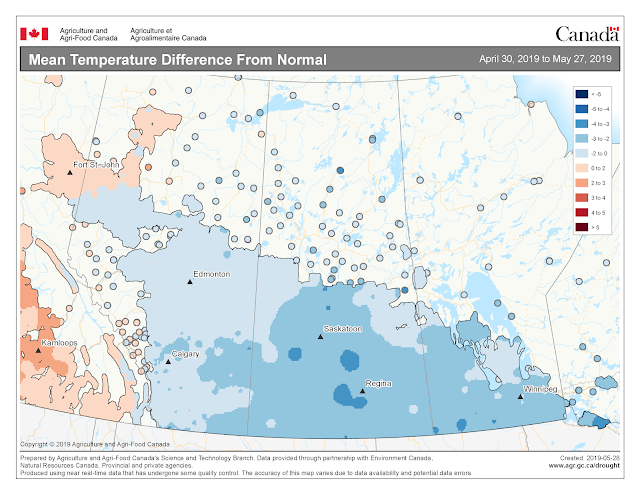Cereal leaf beetle (Oulema melanopus) - The CLB model was run for Brandon MB (Fig. 1), Lethbridge AB (Fig. 2), Grande Prairie AB (Fig. 3) and projected to June 15, 2019. The cereal leaf beetle model indicates that eggs may begin to hatch later next week in Brandon (Fig. 1) and Lethbridge (Fig. 3). Hatch is predicted to be 4-7 days later in the Peace River region (Fig. 3).
 |
| Figure 1. Projected predicted status of cereal leaf beetle populations near Lethbridge AB to June 15, 2019,generated using long term average temperatures. |
 |
| Figure 2. Projected predicted status of cereal leaf beetle populations near Brandon MB to June 15, 2019,generated using long term average temperatures. |
 |
| Figure 3. Projected predicted status of cereal leaf beetle populations near Grande Prairie AB to June 15, 2019,generated using long term average temperatures. |
Lifecycle and Damage:
Adult: Adult cereal leaf beetles (CLB) have shiny bluish-black wing-covers (Fig. 2). The thorax and legs are light orange-brown. Females (4.9 to 5.5 mm) are slightly larger than the males (4.4 to 5 mm). Adult beetles overwinter in and along the margins of grain fields in protected places such as in straw stubble, under crop and leaf litter, and in the crevices of tree bark. They favour sites adjacent to shelter belts, deciduous and conifer forests. They emerge in the spring once temperature reaches 10-15 ºC and are active for about 6 weeks. They usually begin feeding on grasses, then move into winter cereals and later into spring cereals.
 |
| Figure 2. Adult Oulema melanopus measure 4.4-5.5 mm long (Photo: M. Dolinski). |
Egg: Eggs are laid approximately 14 days following the emergence of the adults. Eggs are laid singly or in pairs along the mid vein on the upper side of the leaf and are cylindrical, measuring 0.9 mm by 0.4 mm, and yellowish in colour. Eggs darken to black just before hatching.
Larva: The larvae hatch in about 5 days and feed for about 3 weeks, passing through 4 growth stages (instars). The head and legs are brownish-black; the body is yellowish. Larvae are usually covered with a secretion of mucus and fecal material, giving them a shiny black, wet appearance (Fig. 3). When the larva completes its growth, it drops to the ground and pupates in the soil.
 |
Figure 3. Larval stage of Oulema melanopus with characteristic feeding
damage visible on leaf (Photo: M. Dolinski). |
Pupa: Pupal colour varies from a bright yellow when it is first formed, to the colour of the adult just before emergence. The pupal stage lasts 2 - 3 weeks. Adult beetles emerge and feed for a couple of weeks before seeking overwintering sites. There is one generation per year.






































